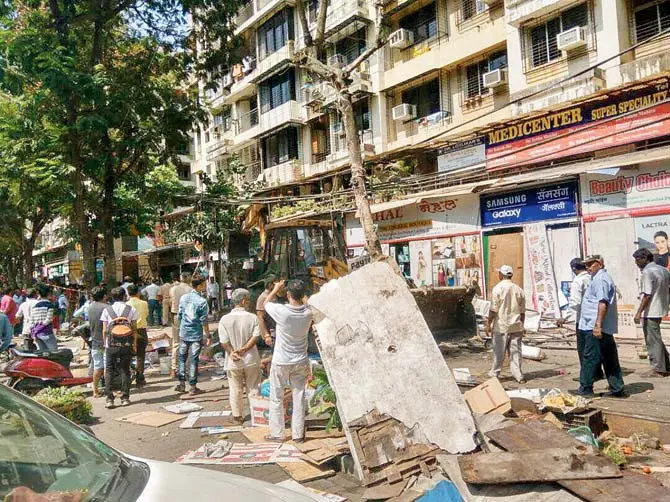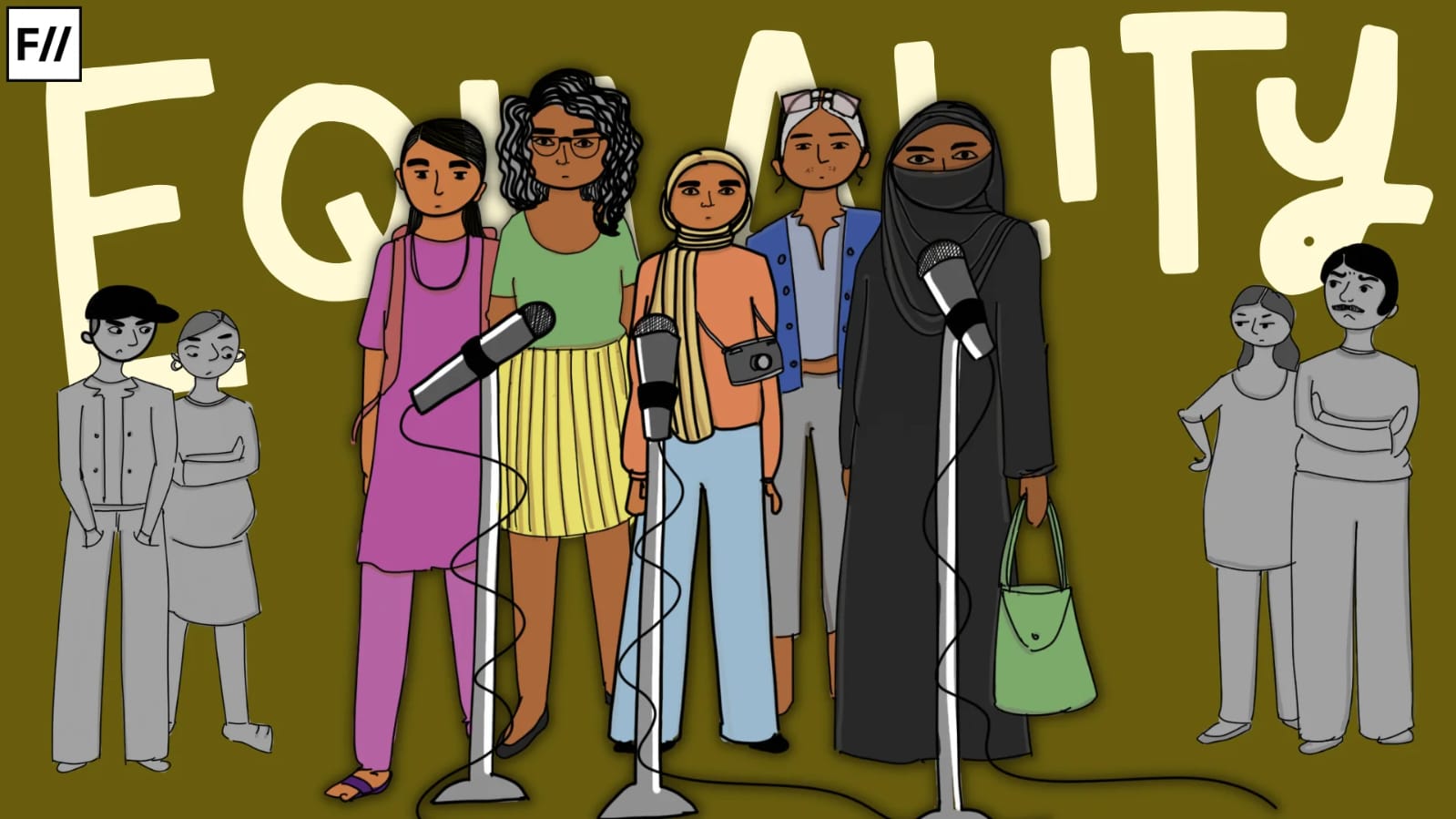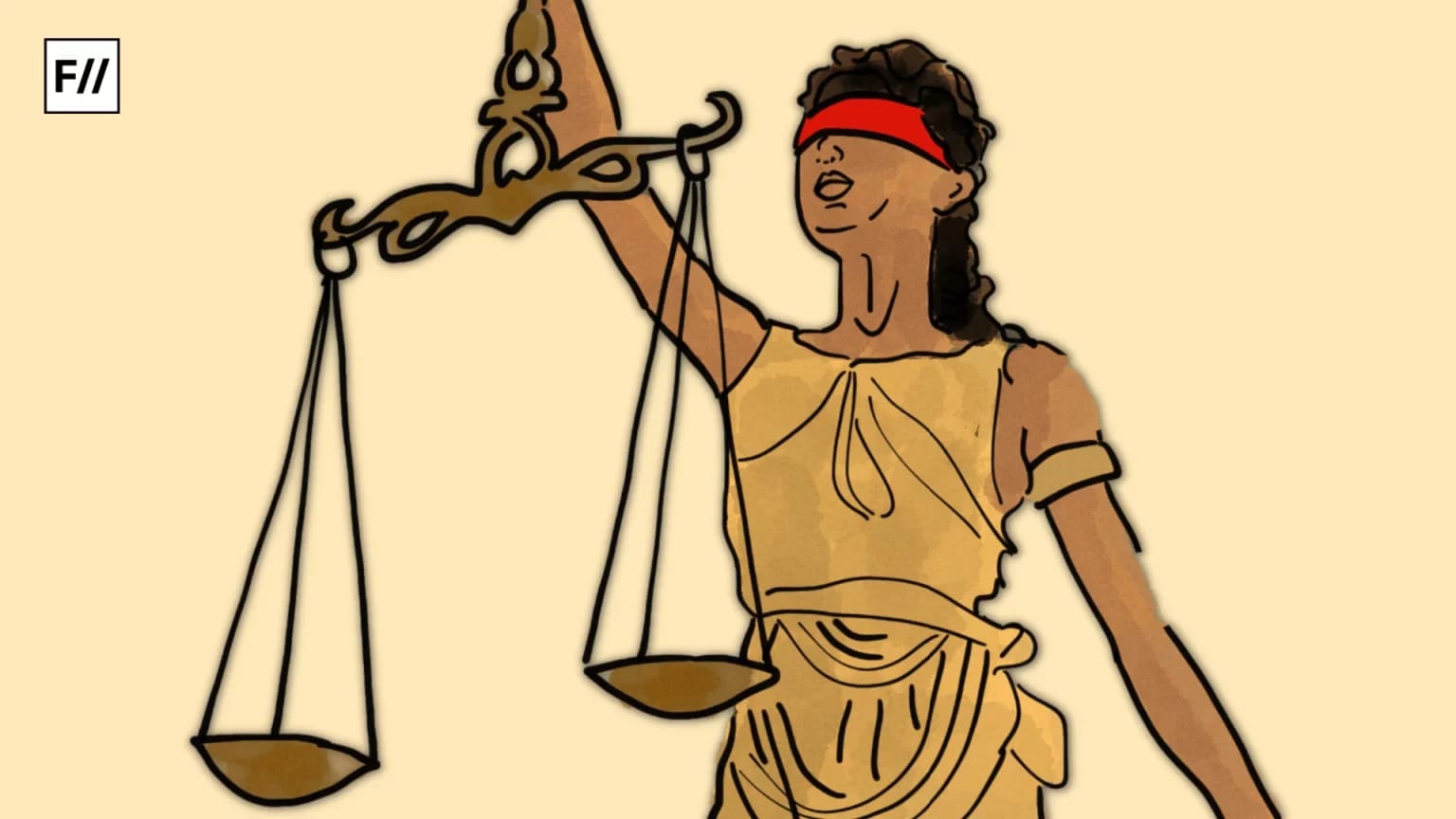Street Vendors in Mumbai and other cities live a precarious existence and are under constant threat of eviction by local municipal bodies. Even though laws exist to protect the right of vendors to a livelihood, in reality, they are not implemented. Most street vendors or hawkers don’t have licences and are regularly evicted in the name of road encroachment or, more recently, beautification and cleanliness drives.
However, a more peculiar reason was adopted by the residents of Mumbai’s Thakur Village area for a recent eviction drive. In May, all the street vendors – approximately 400, according to unofficial estimates – were forcibly removed. The official complaint made the claim that the street vendors were ‘blocking public roads, footpaths and society peripheries’ and further, they were “creating challenges in terms of safety, hygiene, basic walkability for women, children and senior citizens” (emphasis by the author). This was the claim made by Devang Dave, a BJP functionary living in the area, who mentioned it in a letter written to Piyush Goyal, the Member of Parliament elected from the Magathane constituency, under which Thakur Village falls. The letter ends with a call to Goyal to bring ‘order, safety, and dignity’ to the area.
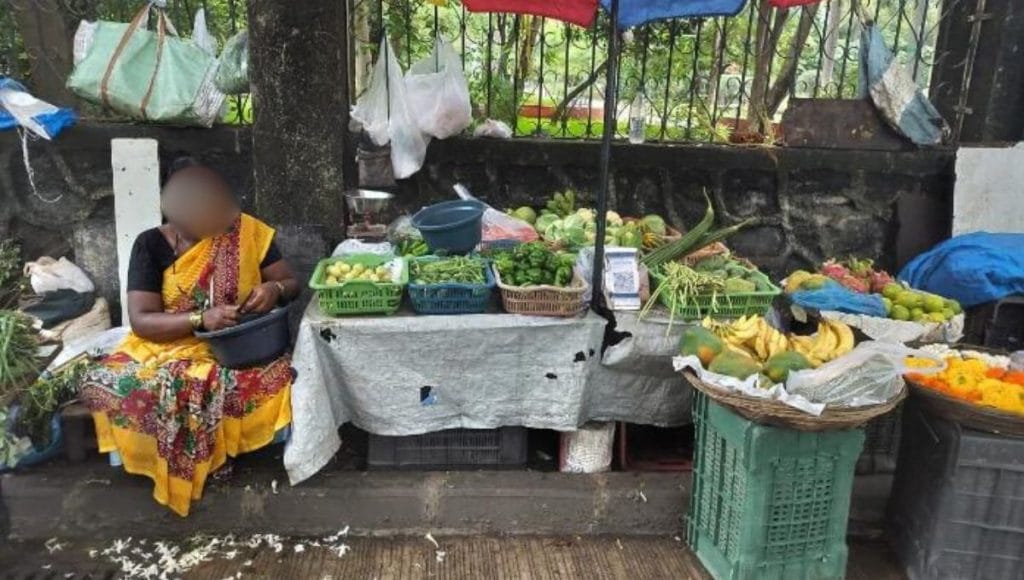
Women’s safety, which is completely unrelated to the existence of street vendors, is used as a reason for their eviction. An unprecedented attack towards the livelihood of street vendors, several of whom are women themselves, is thus being conducted in the name of women’s safety. In the recent past, we have seen policy decisions and other steps being taken by the central and state governments which weaponise women’s upliftment for other ulterior motives. For instance, its intention of bringing the Uniform Civil Code was also touted as a move to protect Muslim women’s rights, although commentators have highlighted its underlying motives of imposing majoritarian beliefs and practices.‘Operation Sindoor,’ a military operation conducted on Pakistan by the armed forces, was touted as ‘bringing honour’ to the widows of the dead civilian men in Pahalgam.
Women’s safety, which is completely unrelated to the existence of street vendors, is used as a reason for their eviction. An unprecedented attack towards the livelihood of street vendors, several of whom are women themselves, is thus being conducted in the name of women’s safety.
Alongside the letter, Dave and other citizens of the area staged a protest against the street vendors, forcing the Brihanmumbai Municipal Corporation (BMC) to clear them from the area. However, as a result of the same, Dave was detained by the police. Upon his return, he thanked the women of the area who ‘prayed for his safe return’.
Street vendors v/s the people
This is not the first time street vendors have been removed from the streets of the area. However, never in the past two decades has the area witnessed a crackdown this severe. The bigger issue, however, is the lack of implementation of existing laws, built primarily for the protection of street vendors.
According to Article-14.com, over three lakh street vendors have been evicted in Mumbai between 2022 and 2024. All this, despite the existence of a central law aimed at protecting the livelihoods of street vendors. The Street Vendors (Protection of Livelihood and Regulation of Street Vending) Act, 2014, recognises street vending as a legal right to livelihood and was passed after the collective struggles of several street vendor associations. Women street vendors, organised as part of the Self-Employed Women’s Association, were the most integral of the participants in the years running up to the passage of the law. (Reeju Ray, 2022)
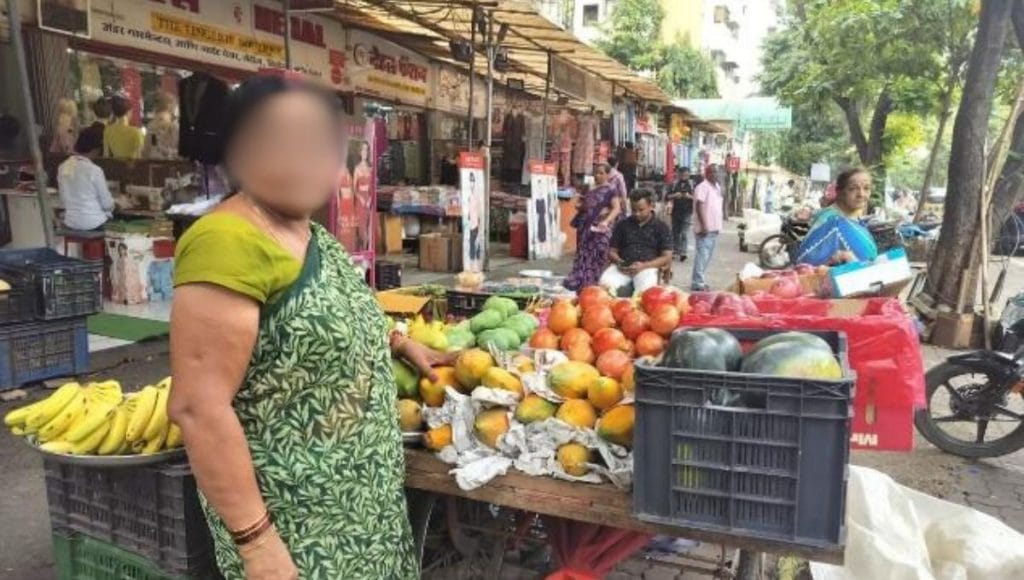
Some prior judgements were critical in the formation of the central Act, including the 1989 judgement. In the 1989 ruling – Sodan Singh and Others vs New Delhi Municipal Committee and Others (1989 Indlaw sc 213) – the defendant invoked Article 19 (1) (g) – the right to practise any profession, trade or business, and Article 21, the right to life and personal liberty. The Act recognises this fundamental right while also providing for the creation of demarcated zones for street vending, so that it doesn’t infringe upon people’s right to walk freely. (SS Sundaram, 2008)
The law states that a Town Vending Committee (TVC) (consisting of elected and nominated individuals) will conduct a survey to determine the street vendors who are eligible to receive a licence. Post that, the eligible street vendors would be allowed to conduct their trade in ‘designated vending zones’. (Reeju Ray, 2022)
Implementation failures
The Act’s success severely depends on the implementation by the states and city administrations. For instance, in August 2024, the Bombay High Court, in response to a PIL, came down harshly on the BMC for not taking any active steps for the creation of a TVC or implementing the Street Vendors Act for the past 10 years. The last TVC election took place in August 2024, after which a committee was elected. However, no progress has been made since then. Before 2024, the BMC website consisted of a list of eligible town vendors for 2019, which was also close to seven years ago. The municipal bodies are thus neglecting the implementation of the Act and instead focusing on outright eviction of the vendors, thereby severely impacting their livelihood.
Impact on working-class women
The residents’ notice in Thakur Village claims that street vendors are dangerous for the safety of women, children and senior citizens. However, what it does instead is that, in the name of women’s safety, it hides the actual harm such a move is having on working-class women and their families. Thus, in a bid to clear the streets for the ‘safety’ of upper-class women and children, the plight of working-class women and children is being invisibilised.
The street vendors in the area now function under the strict surveillance of the police, which makes rounds every few hours in the area. The vendors are unable to conduct business for more than a few hours a day, dropping their monthly earnings to 10-20% of their regular business.
The street vendors in the area now function under the strict surveillance of the police, which makes rounds every few hours in the area. The vendors are unable to conduct business for more than a few hours a day, dropping their monthly earnings to 10-20% of their regular business. The vendors, however, continue to hold their space, and their stalls, especially the vegetable carts, which are propped up such that they can be quickly wound up if the police raid.
Hema Parulekar*, 43, runs her stall early in the morning till 10 AM, after which the police raids intensify. Until then, she can run her business for a few hours. If she used to make INR 4000 a month earlier, now it’s less than half. She claims that, more often than not, in the past month and a half, they have been charged huge fines, sometimes to the tune of INR 2500 for their stalls; however, they continue to keep the stalls. There are seven people in her household, and although her two sons work, it is not enough. Till now, they have been surviving on savings, and the money she is earning is just enough to take care of her immediate needs, such as food.
Anita Seth, 52, another female vegetable vendor, claims she has been in the area for 24 years and has seen nothing like this before. She is the sole earning member in her household of eight people. She broke down as she narrated the difficult straits the family is going through currently, as their debt piles up and the earnings fall. ‘If this goes on for another month, we will die of hunger,’ she adds.
Seth also claims that she has a licence or a Certificate of Vending (CoV); however, the police or the BMC don’t recognise the street vendors and continue to harass them. While vegetable vendors are in a position to pack up their wares and hide them when the van arrives, those selling food and snacks are not in the same position to do so.
Crackdown on food vendors
Bhawana, 25, who, along with her family, runs Jagtap Misal, has been holding her stall for 15 years. However, lately she is making 10% of the total money they usually make in a month, and working only five hours a day. They have been surviving the past month on their savings. ‘How is this unsafe for anyone? We come here as early as 3:30 AM daily to set up our stalls. When we come, it’s pitch dark. I don’t think this is unsafe for anyone, or that anything has happened to the people living here.’ Like most street vendors, this is the sole source of income for her family of five. She had been taken to the police station to pay a fine on the day of the interview, and claims that in the past two months, she has paid fines worth INR 10,000. ‘This is depleting our savings, but what can we do?’ she says.
Bhawana and her family standing next to her stall – Jagtap Misal – minutes before she wrapped up her wares. Even as we spoke, she and her brothers were conducting their business from a rickshaw, which had all the food stocked and was ready to flee in case the police arrived at the location.
We haven’t made any money at all. We are jobless right now,’ said one person. ‘These people need to realise that they aren’t just evicting 400 vendors; it is affecting 400 families. This is the time for my children’s admissions, where am I going to get that money?
Several other food stall owners were seated in the area, only manning their locations, with no wares to sell. ‘We haven’t made any money at all. We are jobless right now,’ said one person. ‘These people need to realise that they aren’t just evicting 400 vendors; it is affecting 400 families. This is the time for my children’s admissions, where am I going to get that money?’ he adds.
While the above are only some of the examples, discussions with numerous street vendors all reflected the same story: helplessness and anxiety over the future.
Decoding the call for ‘dignified’ living spaces
‘During the pandemic, we have gone to the people living in these homes and delivered their groceries to them, putting ourselves fully at risk. And now they want us to go away?’ says Jeetendra Tiwari, one of the street vendors affected by this crackdown. In spite of being central to the functioning of most cities, street vendors are ill-treated and viewed as encroachers and criminals. Why is street vending as a trade undignified? What makes certain professions dignified and others not so?
What is happening in Mumbai is a reflection of the BJP’s drive towards projecting the idea of clean cities, as seen from the latest drive to clear street vendors and bastis in Delhi. Instead of trying to engage with the ideas of sanitation and waste disposal, such moves do nothing to engage with the issues of cleanliness. They are merely dog whistles which hide the greater ‘development’ agenda of the party, which includes high-scale real estate development, which more often than not always comes at the cost of the poor and the marginalised.
Empty roads are thus the equivalent of clean spaces, while those with street vendors are instantly viewed as infected or worse, as in the case of Thakur Village – undignified. What such terms inherently imply is that street vendors are unclean elements of society who need to be pushed away from the streets, which are pristine and unaffected otherwise.
These ideas reflect a colonial and casteist perspective towards development, equating safety and cleanliness with Western and, oftentimes, upper caste ideas of hygiene and purity. Politicians such as Dave, who are eager to shine, are doing so on the backs of lower-class street vendors, several of them women, who are helpless. More distressingly, such moves are coming under the garb of safety for ‘women and children’, which is hogwash that seeks to obscure bigger political agendas.
(The quotes are the author’s free translation from Hindi. Some of the quotes in this article have been edited for clarity and length.)
(*Names of the street vendors mentioned have been changed.)
